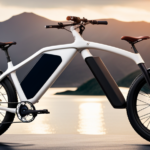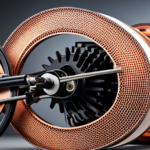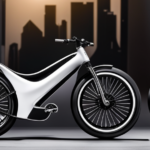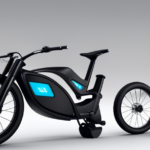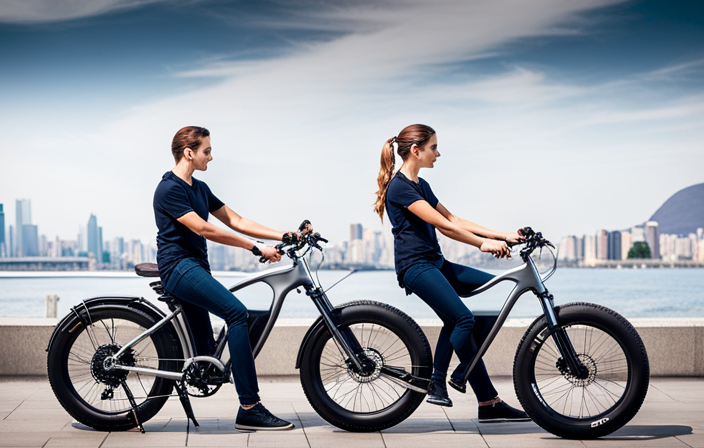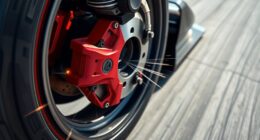I’ve always been fascinated by the power and freedom that electric bikes provide. Picture yourself effortlessly gliding through the streets, the wind at your back, and the hum of the motor propelling you forward.
But how do you know how much wattage you need for your electric bike? In this article, we’ll delve into the technical aspects, assessing your riding style, considering terrain, and even exploring future upgrades.
Get ready to make an informed decision and enjoy the ride!
Key Takeaways
- The power of an electric bike is measured in watts.
- The terrain and gradient of your riding routes will determine the wattage you need.
- Consider the weight and load you’ll be carrying on the bike when determining the necessary wattage.
- It’s important to consider future upgrades and customization options when selecting an electric bike.
Understanding the Basics of Electric Bikes
Understanding the basics of electric bikes is essential when determining how much wattage you need. When assessing your budget, it’s important to consider the different brands available in the market. Comparing brands will give you an idea of the price range and features offered by each.
Electric bikes, also known as e-bikes, are bicycles that are equipped with an electric motor to assist with pedaling. They come in various styles and designs, ranging from city bikes to mountain bikes. The key component of an electric bike is the motor, which determines the amount of power it can provide. This power is measured in watts.
Higher wattage motors generally offer more power and assist with pedaling over longer distances and steeper terrains. However, they also tend to be more expensive. It’s important to find the right balance between power and cost when assessing your needs.
In addition to wattage, other factors to consider when choosing an electric bike include battery capacity, range, and weight. Assessing your riding style and needs will help determine the right combination of these features for you.
Whether you’re a casual rider or a hardcore mountain biker, understanding the basics of electric bikes will ensure that you make an informed decision when selecting the right wattage for your needs.
Assessing Your Riding Style and Needs
When it comes to assessing your riding style and needs, there are a few key points to consider.
Firstly, think about whether you will primarily use your electric bike for commuting or leisure riding. This will determine the type of bike and features you should prioritize.
Secondly, if you’re someone who enjoys off-roading or mountain biking, you’ll want to look for an electric bike that is specifically designed for these activities, with features like robust suspension and durable tires.
Taking the time to assess your riding style and needs will ensure that you choose the right electric bike for your preferences and maximize your enjoyment of the ride.
Commuting or Leisure Riding
For commuting or leisure riding, you’ll want to consider how much wattage you need for your electric bike. A good set of lights is essential for safety, especially if you plan on riding at night or in low light conditions. A sturdy rack or basket can also come in handy for carrying groceries or other items.
As for maintenance tips, keeping your electric bike clean and dry is crucial. Regularly inspecting the tires, brakes, and chain for any signs of wear and tear is also important. Additionally, make sure to keep your battery charged and properly stored when not in use.
Now, let’s transition to the next section about off-roading or mountain biking.
Off-Roading or Mountain Biking
If you’re into off-roading or mountain biking, it’s important to choose a durable and rugged electric bike that can handle rough terrain. When it comes to bike selection, there are a few key factors to consider. One of the most important aspects is the motor type. The motor determines the power and performance of the bike, especially when tackling challenging trails. There are two main types of motors commonly found in electric bikes: hub motors and mid-drive motors.
| Motor Type | Pros | Cons |
|---|---|---|
| Hub Motors | – Simple and low maintenance |
- Good for flat terrain
- Less expensive | – Limited torque
- Not suitable for steep climbs
- Rear-wheel weight distribution |
| Mid-Drive Motors | – More torque and power - Better for steep climbs
- Improved weight distribution | – Higher maintenance
- More expensive
- Requires frequent gear shifting |
Considering the terrain and gradient of your off-roading or mountain biking adventures is crucial. This will determine the motor power and type you need to conquer those rugged trails.
Considering Terrain and Gradient
When considering the terrain and gradient for an electric bike, it’s important to assess whether you will be riding on flat or hilly terrain. This will help you determine the power assistance you will need.
Flat terrain requires less power assistance, so you may not need a very powerful motor or high wattage output.
On the other hand, if you will be riding on hilly terrain or facing steep inclines, you will need a more powerful motor and higher wattage output. This will ensure that you have enough power to tackle the hills and inclines with ease.
If you plan on tackling mountains, it’s crucial to choose an electric bike with a motor capable of handling the steep gradients effectively. This will ensure that you can conquer the mountains without any issues.
Flat or Hilly Terrain
Riding an electric bike on hilly terrain will require more wattage than on flat terrain. This is because when you encounter inclines, the motor power needs to work harder to maintain a consistent speed. Here are four key factors to consider when determining the wattage you need for hilly terrain:
-
Electric Bike Battery: A higher wattage battery will provide more power for tackling hills. Look for a battery with a higher voltage and capacity to ensure sufficient energy for uphill rides.
-
Motor Power: A more powerful motor will offer better performance on hilly terrain. Look for a motor with higher wattage to ensure it can handle the increased demands of climbing steep slopes.
-
Torque: A higher torque rating will provide better hill-climbing ability. Look for a motor with a torque sensor or a mid-drive motor, as they tend to deliver more torque for uphill riding.
-
Gear System: A bike with multiple gears allows you to adjust the resistance and find the right gear ratio for climbing hills. Having a wide range of gears will make uphill riding easier.
When considering wattage for hilly terrain, it’s important to take into account these factors to ensure a smooth and efficient ride.
Now, let’s explore how wattage requirements change when facing steep inclines or mountains.
Steep Inclines or Mountains
Moving on from the discussion about flat or hilly terrain, let’s now delve into the realm of steep inclines or mountains.
When facing such challenging topography, it becomes crucial to consider the motor power and battery capacity of an electric bike. Steep inclines require more power to conquer, and a motor with higher wattage will provide the necessary torque for climbing. It is essential to choose an electric bike with a powerful motor that can handle the increased demand in these situations.
Additionally, battery capacity plays a vital role in tackling steep inclines or mountainous landscapes. A higher battery capacity ensures that the bike can sustain the necessary power output throughout the ride, allowing you to conquer those challenging terrains without any issues.
Transitioning into the subsequent section, let’s now explore the impact of weight and load capacity on electric bikes.
Weight and Load Capacity
The weight and load capacity of an electric bike determines how much wattage you need. When considering an electric bike, it is important to understand the load capacity limitations and how weight distribution affects the overall performance. Load capacity refers to the maximum weight that an electric bike can safely carry, including the rider and any additional cargo. Exceeding this limit can put strain on the motor and other components, leading to reduced efficiency and potential damage.
Weight distribution is another crucial factor to consider. Uneven weight distribution can affect the stability and handling of the electric bike, especially when maneuvering through tight turns or uneven terrains. It is recommended to distribute the weight evenly between the front and rear racks or baskets, ensuring a balanced ride.
Understanding the weight and load capacity requirements will help you determine the appropriate wattage for your electric bike. By knowing the maximum load capacity and considering weight distribution, you can select an electric bike with sufficient power to handle your needs.
Moving on to battery range and life, it is essential to consider these factors when evaluating an electric bike’s performance.
Battery Range and Life
When it comes to electric bikes, determining your daily distance is crucial in understanding the battery range you will need. By considering factors such as your commute length and any additional rides you plan to take, you can ensure that your battery can sustain your desired mileage.
Additionally, understanding battery longevity and charging time will help you make informed decisions about maintenance and planning your rides.
Determining Your Daily Distance
To accurately determine your daily distance, you’ll want to track the miles you travel on your electric bike. This will help you understand the range of your electric bike and how far you can go on a single charge. The electric bike range is influenced by various factors, such as battery capacity, terrain, rider weight, and assist level. By monitoring your daily distance, you can assess if your electric bike meets your needs or if you require a bike with a longer battery capacity. Here is a table outlining the estimated electric bike range based on battery capacity:
| Battery Capacity (Wh) | Estimated Range (miles) |
|---|---|
| 300 | 20-30 |
| 500 | 30-50 |
| 750 | 50-75 |
| 1000 | 75-100 |
Understanding your daily distance will also help you plan your rides and determine when you need to recharge your battery. Speaking of recharging, let’s now explore battery longevity and charging time.
Battery Longevity and Charging Time
Monitoring your daily distance helps you understand how long your battery will last and how quickly it will need to be recharged. When it comes to battery longevity and charging time, two crucial factors to consider are battery capacity and charging infrastructure.
Battery capacity refers to the amount of energy a battery can store, typically measured in watt-hours (Wh). The higher the battery capacity, the longer your electric bike can run before needing to be recharged.
Additionally, the charging infrastructure plays a vital role in determining how quickly you can recharge your battery. Having access to fast charging stations or a home charging setup with high power capabilities can significantly reduce the charging time.
Now, let’s delve into the next section discussing motor power and performance.
Motor Power and Performance
When it comes to electric bike motors, there are two main types to consider: hub motors and mid-drive motors.
Each has its own advantages and it’s important to understand the differences in power output and speed.
Hub motors are typically located in the center of the wheel and offer direct power to the tire, resulting in a higher top speed but sacrificing some torque.
On the other hand, mid-drive motors are positioned near the bike’s bottom bracket, allowing for better weight distribution and increased torque, making them ideal for off-road or hilly terrain.
Hub Motors vs. Mid-Drive Motors
You might be wondering which type of motor is better for your electric bike: hub motors or mid-drive motors?
When it comes to motor efficiency and power delivery, both types have their advantages. Hub motors are located in the center of either the front or rear wheel and provide direct power to the wheel. This design offers simplicity and ease of installation, making it a popular choice for many electric bike enthusiasts.
On the other hand, mid-drive motors are positioned near the bottom bracket of the bike, allowing for better weight distribution and improved handling. They also offer better motor efficiency and power delivery, as the motor leverages the bike’s existing gears.
Now, let’s dive into the next section, where we’ll discuss power output and speed.
Power Output and Speed
After understanding the differences between hub motors and mid-drive motors, it is important to delve into the topic of power output and speed.
When it comes to electric bikes, power efficiency is key. With advancements in battery technology, it is now possible to achieve higher power outputs while maintaining longer battery life. The power output of an electric bike is measured in watts, which determines how much force the motor can provide.
Higher wattage generally results in faster speeds and better acceleration. However, it is important to strike a balance between power and battery life. Opting for a higher power output might drain the battery faster, reducing the overall range of the bike.
In the next section, we will explore the different pedal assist levels that can further enhance the riding experience.
Pedal Assist Levels
When it comes to electric bikes, understanding pedal assist levels is crucial for getting the most out of your riding experience.
Pedal assist levels classify the amount of assistance the motor provides when you pedal. This classification system allows riders to choose the level of assistance that suits their needs and preferences.
Additionally, customizable assist modes allow riders to further tailor their electric bike’s performance to their liking, providing a truly personalized riding experience.
Classifying Pedal Assist Levels
Classifying pedal assist levels helps to determine how much wattage is needed for an electric bike. With advancements in e-bike technology, riders now have the ability to customize their settings to suit their individual preferences and riding conditions. This customization allows for a more personalized and efficient riding experience. By classifying pedal assist levels, riders can easily understand the amount of assistance they will receive from the electric motor. The table below illustrates the different pedal assist levels and their corresponding wattage requirements:
| Pedal Assist Level | Wattage Required |
|---|---|
| Level 1 | 100W |
| Level 2 | 200W |
| Level 3 | 300W |
These classifications provide a clear understanding of the power output needed for each level of assistance. Transitioning into the next section, customizable assist modes allow riders to further tailor their e-bike’s performance without the need for additional steps.
Customizable Assist Modes
Riders can easily personalize their e-bike’s performance through customizable assist modes. With the ability to adjust power settings, riders have the freedom to tailor their riding experience to their specific preferences. Here are four key features of assist mode customization:
-
Variable Power Output: Riders can choose how much power the motor provides, allowing them to conserve battery life or have a more powerful ride.
-
Speed Limit Adjustments: Riders can set a maximum speed for their e-bike, ensuring they stay within legal limits or enjoy a faster ride.
-
Acceleration Sensitivity: Riders can adjust how quickly the motor responds when they start pedaling, providing a more seamless and natural riding experience.
-
Regenerative Braking: Some e-bikes allow riders to customize the amount of energy that is regenerated when braking, maximizing efficiency and extending battery life.
By providing these customizable options, e-bike manufacturers empower riders to personalize their riding experience based on their individual preferences.
However, it’s important to note that while assist mode customization is a valuable feature, it is still subject to legal regulations and restrictions.
Legal Regulations and Restrictions
There are specific legal regulations and restrictions that determine the wattage requirements for electric bikes. When it comes to regulations compliance, it is essential to understand the rules set forth by the governing bodies in your region. Different countries and states have varying requirements, so it is crucial to familiarize yourself with the specific laws that apply to your area.
In terms of speed limits, electric bikes generally have a maximum speed limit that they must adhere to. This limit is often around 20 mph (32 km/h), although it can vary depending on local regulations. To comply with these regulations, electric bikes are typically designed with motors that provide enough power to reach and maintain these speeds without exceeding them.
Transitioning into the subsequent section about budget and cost considerations, it is important to note that while there are legal requirements to consider, there are also financial factors to keep in mind. Understanding the wattage requirements can help you determine the type of electric bike that best suits your needs and budget.
Budget and Cost Considerations
When it comes to purchasing an electric bike, two important factors to consider are the price range and the value for money.
Electric bikes can vary greatly in price, ranging from affordable options to high-end models. It is essential to assess the features, components, and overall quality of the bike to determine if it provides good value for the price.
Additionally, it is crucial to take into account any additional expenses that may arise, such as accessories, maintenance, and repairs, as these can significantly impact the overall cost of owning an electric bike.
Price Range and Value for Money
If you’re on a budget, it’s important to consider the price range and value for money when deciding on the wattage for an electric bike. To help you make an informed decision, I’ve compiled a price range comparison table below that outlines some cost-effective options available in the market:
| Electric Bike Model | Wattage (W) | Price Range ($) |
|---|---|---|
| Model A | 250 | $500-$700 |
| Model B | 500 | $800-$1000 |
| Model C | 750 | $1000-$1500 |
| Model D | 1000 | $1500-$2000 |
| Model E | 1500 | $2000-$2500 |
As you can see, there is a range of wattages available at different price points. It’s important to choose a wattage that aligns with your budget and riding needs. Consider factors such as terrain, desired speed, and distance you plan to travel. Additionally, keep in mind that higher wattage typically translates to more power and acceleration. Now that we have discussed the price range and value for money, let’s move on to the next section where we will explore additional expenses such as accessories and maintenance costs.
Additional Expenses (Accessories, Maintenance, etc.)
To get the most out of your electric bike, it’s important to factor in the cost of accessories and maintenance expenses. While the initial price of the bike is a significant consideration, it’s crucial to also think about the long-term investment. Here are some key expenses to keep in mind:
-
Accessories cost: Accessories such as lights, fenders, racks, and locks can enhance your electric bike experience, but they come at a cost. It’s essential to budget for these add-ons to ensure you have everything you need for a comfortable and safe ride.
-
Maintenance schedule: Electric bikes, like any other mode of transportation, require regular maintenance. This includes tasks like battery maintenance, tire checks, brake adjustments, and general cleaning. Creating a maintenance schedule and accounting for the associated costs will help keep your electric bike in optimal condition.
-
Spare parts: Over time, certain parts of your electric bike may wear out and need replacing. It’s wise to set aside some funds for spare parts like brake pads, chains, and tires. This way, you’ll be prepared when the time comes to replace them.
-
Professional servicing: While you can handle some maintenance tasks yourself, certain repairs may require the expertise of a professional. It’s advisable to budget for occasional servicing to ensure your electric bike is running smoothly and efficiently.
Considering these additional expenses will give you a comprehensive understanding of the true cost of owning an electric bike.
Now that you are aware of the financial aspects, let’s move on to the next section where we explore the importance of test riding and consulting experts to choose the right electric bike for your needs.
Test Riding and Consulting Experts
When it comes to finding the perfect electric bike, I highly recommend trying out different models and brands. Each one has its own unique features and specifications that may suit your needs better than others.
Additionally, seeking advice from e-bike enthusiasts can provide valuable insights and recommendations based on their own experiences and expertise in the field.
Trying Different Models and Brands
You should consider trying out different models and brands to determine the wattage you need for an electric bike. This is an important step in finding the right electric bike for your needs. By test riding different models, you can get a feel for the power and performance of each bike. This will help you determine the wattage that suits your riding style and terrain.
Additionally, consulting with experts in the field can provide valuable insights and recommendations based on your specific requirements. Here are three benefits of test riding and consulting with experts:
- Allows you to experience the performance and handling of different electric bikes firsthand.
- Helps you understand the differences in wattage and how it affects the bike’s power and range.
- Provides an opportunity to ask questions and receive personalized advice from knowledgeable professionals.
Seeking Advice from E-Bike Enthusiasts
Seeking advice from e-bike enthusiasts can provide valuable insights and recommendations based on their expertise and experience. They can help you understand how different battery capacities affect the overall performance of the bike, such as the maximum speed and distance it can cover. Enthusiasts can also offer guidance on finding the right balance between power and range. Additionally, they can provide valuable input on motor torque and acceleration, explaining how motor torque affects the bike’s ability to climb hills and accelerate quickly. They can even recommend motors with optimal torque levels for your specific needs. By tapping into the knowledge of e-bike enthusiasts, you can make informed decisions about battery capacity and motor performance for your electric bike.
Moving forward, let’s explore the safety and comfort features to consider for a well-rounded e-bike experience.
Safety and Comfort Features
The electric bike should have safety and comfort features such as a reliable braking system and a cushioned seat. In addition to these essential features, it is important to consider other aspects that can enhance your riding experience.
One such feature is an adjustable suspension system, which allows you to customize the bike’s suspension to your preferred level of comfort and terrain. This ensures a smooth and stable ride, especially when encountering bumps or uneven surfaces.
Another important feature to consider is integrated lights. These lights are built into the bike’s frame or handlebars, providing increased visibility and safety during low-light conditions or at night. Having integrated lights eliminates the need for separate, detachable lights that can be easily lost or forgotten.
By incorporating adjustable suspension and integrated lights into the design of an electric bike, manufacturers prioritize safety and comfort for riders. These features enhance the overall riding experience and provide peace of mind knowing that you have the necessary tools to navigate various terrains and conditions.
When considering an electric bike, it is also crucial to evaluate the warranty and customer support offered by the manufacturer. This ensures that you have access to assistance and potential repairs should any issues arise with your bike. With reliable warranty coverage and responsive customer support, you can have confidence in your purchase and enjoy your electric bike for years to come.
Warranty and Customer Support
When considering the purchase of an electric bike, it’s crucial to examine the manufacturer warranty and service options available. A comprehensive warranty can provide peace of mind and financial protection in case of any defects or malfunctions.
Additionally, the availability of spare parts is essential for the long-term maintenance and repair of the electric bike, ensuring its longevity and optimal performance.
Manufacturer Warranty and Service
To ensure you’re covered in case of any issues, have you checked if the manufacturer warranty includes service for your electric bike? It’s crucial to understand the terms and conditions of your manufacturer warranty, as it provides a safety net for potential repairs or replacements.
The manufacturer warranty typically outlines the duration of coverage and the specific components or parts that are included. Some warranties may also offer additional services like free maintenance or technical support. By taking advantage of the manufacturer warranty, you can ensure that any potential issues with your electric bike will be addressed promptly and professionally.
Now, let’s move on to the next important consideration: the availability of spare parts.
Availability of Spare Parts
Have you considered checking the availability of spare parts for your e-bike? It’s an important aspect to consider when purchasing an electric bike. Here are three key points about spare parts availability and its impact on cost efficiency:
-
Wide Range of Parts: It’s crucial to choose an e-bike brand that offers a wide range of spare parts. This ensures that you can easily find and replace any components that may wear out or break over time.
-
Cost-Effective Repairs: When spare parts are readily available, it becomes easier to repair your e-bike without incurring high costs. You can simply replace the faulty part instead of having to replace the entire bike or pay for expensive repairs.
-
Longevity of E-Bike: By checking the availability of spare parts, you can ensure that your e-bike will last for a long time. Having access to spare parts allows you to maintain and fix your bike, keeping it in optimal condition for years to come.
Considering spare parts availability is essential for cost efficiency and the longevity of your e-bike. It ensures that you can easily maintain and repair your bike without breaking the bank.
Moving forward, let’s explore the crucial topic of e-bike maintenance and upkeep.
E-Bike Maintenance and Upkeep
Regular maintenance is essential for keeping your e-bike in good condition. One of the most important aspects of maintenance is taking care of the e-bike battery. Proper battery care can significantly extend its lifespan and ensure optimal performance.
To keep your battery in top shape, avoid exposing it to extreme temperatures and always store it in a cool, dry place. It’s also crucial to charge the battery regularly, even if you’re not using the e-bike. This helps prevent the battery from losing its charge completely, which can lead to irreversible damage.
In addition to battery care, troubleshooting common e-bike issues is another important part of maintenance. One common issue is a sudden loss of power. This can be caused by a loose connection or a faulty motor. Check all the cables and connections to ensure they are secure. If the problem persists, it might be necessary to consult a professional for further diagnosis and repair.
As you maintain your e-bike, you may also consider future upgrades or modifications to enhance its performance or customize it to your needs. Whether it’s upgrading to a higher-capacity battery or adding accessories like a rear rack or lights, these modifications can enhance your riding experience.
Considering Future Upgrades or Modifications
After ensuring proper maintenance and upkeep of your electric bike, it’s important to consider the potential for future upgrades or modifications. As technology advances and new components become available, you may want to enhance your e-bike’s performance and capabilities. Here are some factors to think about when considering future upgrades:
-
Battery Upgrade: Upgrading to a higher capacity battery can extend your e-bike’s range and allow for longer rides without recharging.
-
Motor Upgrade: Upgrading to a more powerful motor can provide increased torque and acceleration, allowing you to tackle steep hills or ride at higher speeds.
-
Suspension Upgrade: Upgrading your bike’s suspension system can improve comfort and handling, especially if you frequently ride on rough or uneven terrain.
-
Component Upgrades: Upgrading other components such as brakes, gears, or tires can further enhance your e-bike’s performance and overall riding experience.
By considering these potential upgrades, you can ensure that your e-bike remains up-to-date and capable of meeting your evolving needs. Whether it’s increasing range, improving acceleration, or enhancing comfort, the right upgrades can take your e-bike to the next level.
Making an Informed Decision and Enjoying the Ride!
To make an informed decision and fully enjoy your ride, it’s crucial to research and understand the potential upgrades available for your e-bike. There are a wide range of bike accessories and maintenance tips that can enhance your riding experience and keep your e-bike in top shape.
When it comes to bike accessories, there are several options to consider. Firstly, you might want to invest in a good quality helmet to ensure your safety on the road. Additionally, a comfortable saddle and ergonomic handlebars can greatly improve your comfort during long rides. Other accessories to consider include lights, mirrors, and a sturdy bike lock for security.
Maintenance is key to keeping your e-bike running smoothly. Regularly check the tire pressure and make sure they are properly inflated for optimal performance. Keep the chain clean and lubricated to prevent rust and ensure smooth shifting. It’s also important to periodically inspect the brakes and make any necessary adjustments. Lastly, don’t forget to regularly charge the battery and store it in a cool, dry place when not in use.
Frequently Asked Questions
Can I ride an electric bike on the highway?
Yes, you can ride an electric bike on the highway. However, it’s important to consider highway safety and adhere to speed limits.
When riding on the highway, it’s crucial to be aware of your surroundings and follow all traffic laws. Electric bikes typically have a maximum speed limit, so it’s essential to stay within that limit to ensure both your safety and the safety of others on the road.
How often do I need to charge the battery of an electric bike?
To ensure optimal performance and longevity of your electric bike’s battery, it is crucial to understand the charging frequency and battery lifespan.
Regular charging is essential, typically depending on your usage and the battery capacity. I recommend charging your electric bike’s battery at least once a week, even if you haven’t completely depleted it.
This practice will help maintain the battery’s health and maximize its lifespan, ensuring a reliable and enjoyable riding experience.
Are there any special maintenance requirements for an electric bike?
There are indeed special maintenance requirements for an electric bike.
First, regular cleaning and lubrication of the chain and gears is essential to ensure optimal performance.
Additionally, it is important to periodically inspect the battery connections and clean them if necessary.
Special tools may be required for tasks such as adjusting the brakes and derailleur.
Lastly, it is crucial to follow the manufacturer’s guidelines for charging the battery to maximize its lifespan.
Can I use an electric bike in rainy weather?
Yes, you can use an electric bike in rainy weather. Electric bikes are designed to be weather-resistant, with components like sealed batteries and waterproof electrical connections.
Riding in the rain can actually have some advantages, such as reduced dust and debris on the road, which can improve traction. However, it is important to take certain safety precautions, such as using fenders to prevent water from spraying onto you and using appropriate tires for wet conditions to ensure optimal grip.
Are there any weight restrictions for riding an electric bike?
Weight restrictions are an important aspect of riding an electric bike. Safety concerns arise when riders exceed the bike’s weight capacity, leading to potential accidents and damage to the bike. It is crucial to check the manufacturer’s guidelines to determine the maximum weight limit for your electric bike.
Exceeding this limit can strain the bike’s components, affect its performance, and compromise your safety. Therefore, always adhere to the weight restrictions specified by the manufacturer to ensure a safe and enjoyable riding experience.
Conclusion
In conclusion, when determining the wattage needed for an electric bike, it is crucial to consider various factors. These factors include riding style, terrain, weight capacity, battery range, and customer support.
However, one interesting statistic to note is that on average, an electric bike with a wattage between 250-500 watts can provide a range of approximately 20-50 miles per charge. This highlights the incredible efficiency and versatility of electric bikes.
This efficiency and versatility make electric bikes a practical and sustainable transportation option for many individuals. Whether you’re commuting to work or exploring new trails, choosing the right wattage for your electric bike will ensure an enjoyable and efficient ride.


